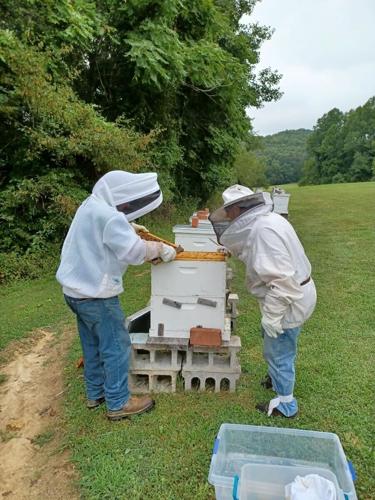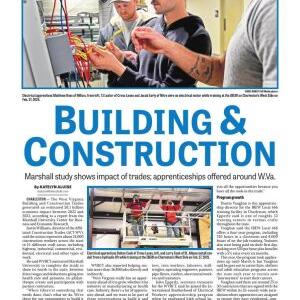West Virginiaňňň˝ĘÓƵ™s honeybees population decline is estimated at about 40% this year, according to the West Virginia Department of Agriculture.
A drought last year, bad weather and an invasive species called the Varroa mite all have led to a record-high number of losses this year, according to Shanda King, an apiarist with the West Virginia Department of Agriculture.
According to King, honeybees require good weather to produce honey because they need to take what is called a ňňň˝ĘÓƵścleansing flightňňň˝ĘÓƵť in warm, sunny weather to expel waste from their system outside the colonies. If they canňňň˝ĘÓƵ™t do this, then it will build up in their system and could lead to dysentery or a fungal disease called nosema, leading to colony losses.
Lasting effects from the drought have also led colonies to suffer because the lack of soil moisture leaves honeybees unable to forage and collect nectar.
The Varroa mite has also been a contributing factor to the declining honeybee population. It is an invasive species that originated in southeast ňňň˝ĘÓƵia and arrived in the mid-1980s. It is intertwined with the beeňňň˝ĘÓƵ™s life cycle by hiding underneath the larvae and being enclosed with them until they have fully developed, allowing the mites to feed on the bee larvae and transfer viruses to them. During this time, they are also laying their own eggs so that by the time the bees have finally matured, the newly hatched mites also crawl out with them, starting the process all over again, meaning it is impossible to raise honeybees without also raising mites, according to King.
It is also hard for beekeepers to eliminate the mites completely and, instead, they need to monitor them and keep them under a certain number.
ňňň˝ĘÓƵśWe couldnňňň˝ĘÓƵ™t point the finger at one thing. It was just a combination of multiple stressors that has caused the increased loss rate,ňňň˝ĘÓƵť King said.
Despite this, West Virginiaňňň˝ĘÓƵ™s honeybee population decline is still lower than the national rate, being about 62%. According to King, it is the largest loss rate in the recorded history of the national loss rate of honeybees.
King said these losses could affect pollination percentages and lead to a lower supply of food sources for wildlife and production for farmers. She also said that an effect on pollination percentages could potentially lead to a smaller food supply if it were severe enough.
Currently, honeybee registration data is still being collected and honey is still being harvested for this season, so it is not fully clear yet how much honey production has been affected by the losses, but many different apiarists have said they were impacted by the decline. While the industry expects to lose a few hives each year, some were hit abnormally hard this year.
Gabe Blatt, former president of the Cabell-Wayne Beekeepers ňňň˝ĘÓƵsociation and owner of Blattňňň˝ĘÓƵ™s Bee Farm in Wayne County, said heňňň˝ĘÓƵ™s lost about 30% to 35% of his bees this year, compared to the 10% to 15% he usually loses. His honey production has also suffered, as the last two years he was able to harvest about 1,200 lbs. of honey, but this year he thinks it will come in at about 600 lbs.
ňňň˝ĘÓƵśEvery one of the beekeepers that I know around the Huntington-Milton area ňňň˝ĘÓƵ¦ are not having a good honey production year this year, including myself,ňňň˝ĘÓƵť he said. ňňň˝ĘÓƵśIňňň˝ĘÓƵ™ll be lucky to have half as much honey this year as I produced last year.ňňň˝ĘÓƵť
State Delegate Daniel Linville, R-Cabell, who is also a hobbyist beekeeper, has hives that were affected by the decline.
Out of the 10 hives he kept, he lost five, but the remaining hives were ňňň˝ĘÓƵśvery strong,ňňň˝ĘÓƵť he said, and he has largely replenished the losses. However, the difficulty with losing hives is that bees will spend much of the first year building it back up entirely, meaning that you will not get much honey production out of that new hive.
ňňň˝ĘÓƵśTheyňňň˝ĘÓƵ™re concentrated primarily on building that up and making sure that all their honeycomb and wax and everything else is built back up,ňňň˝ĘÓƵť he said. ňňň˝ĘÓƵśThey will spend that year, sort of, rebuilding their house ňňň˝ĘÓƵ¦ as compared to producing excess honey.ňňň˝ĘÓƵť
King and Blatt both sell honey and have both described needing to consider raising honey prices due to the decline, although they also attribute this need to rising supply and equipment costs.
Blatt described the rising cost of jars in particular, as well as equipment like woodenwares and beekeeping suits, that caused him to raise his prices.
ňňň˝ĘÓƵśTo me, those things have affected my pricing more than the bees and the honey,ňňň˝ĘÓƵť he said. ňňň˝ĘÓƵśThose things really hurt, and you just gotta raise your prices a little bit to compensate.ňňň˝ĘÓƵť
King said there are three things everyone can do to protect the honeybee population and help stop the decline. She suggests people buy local honey to support local beekeepers; minimize pesticide use or, if they have to use it, follow the label in order to maximize pollinator protection; and maintain biodiversity and allow plants that bloom in their yards to feed pollinators.
ňňň˝ĘÓƵśYou can think about your property as a buffet, or potentially a desert,ňňň˝ĘÓƵť she said. ňňň˝ĘÓƵśYou can choose to feed the bees or not feed them.ňňň˝ĘÓƵť
















